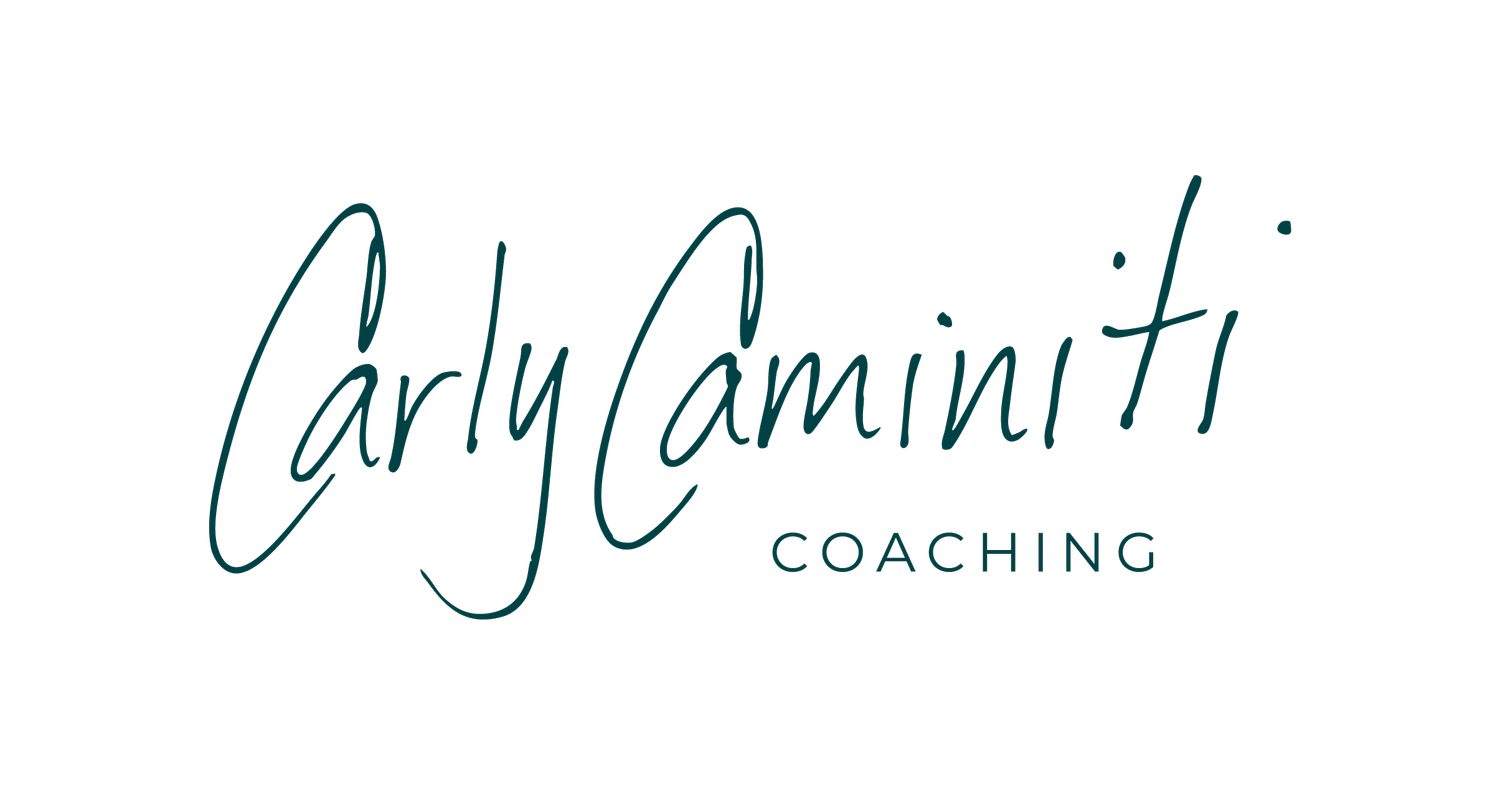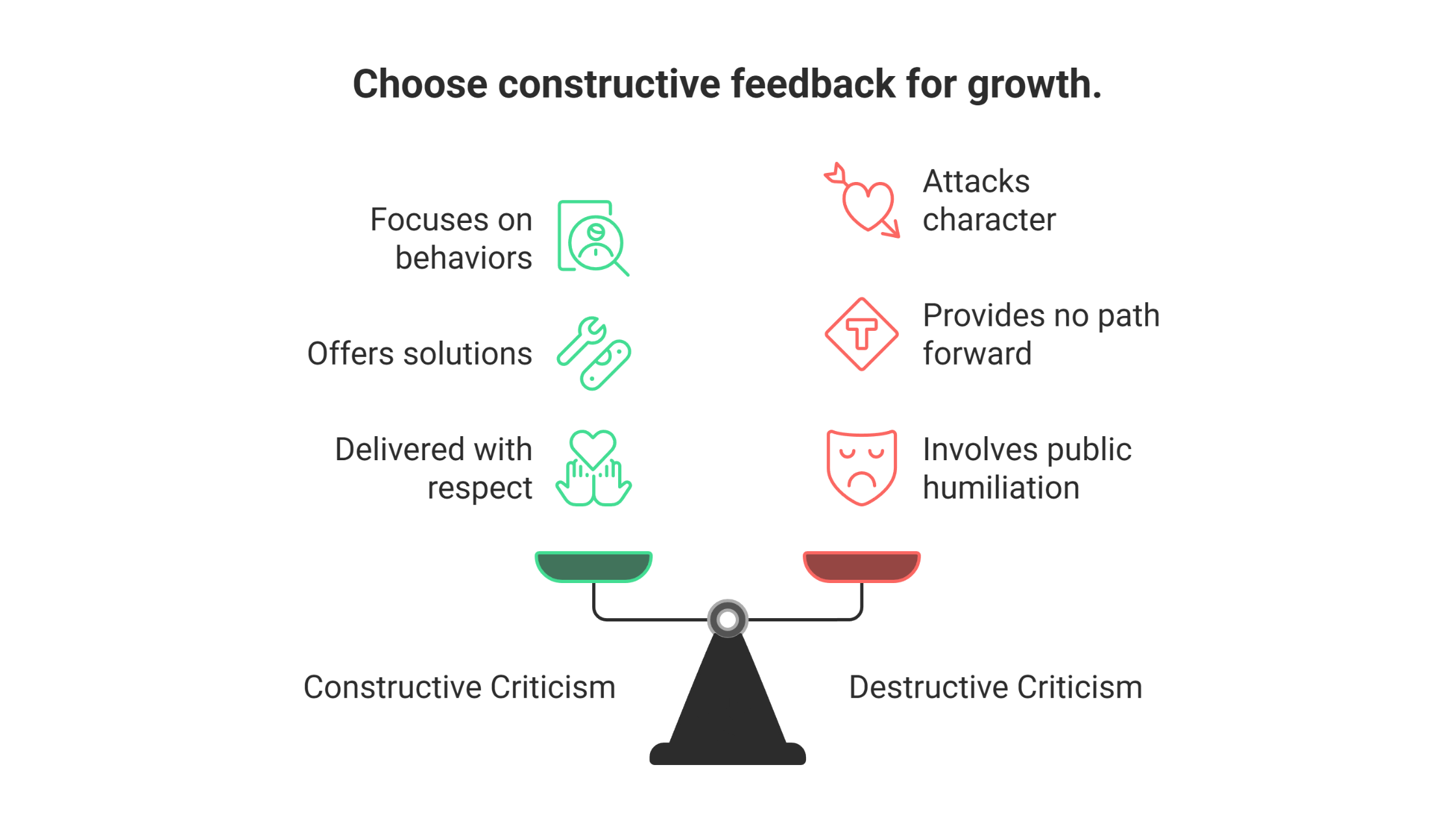How to Handle Criticism at Work: 7 Pro Tips
Learning how to handle criticism at work is one of the most valuable skills you can develop professionally. Whether you're receiving feedback from your manager, a peer, or a client, the way you respond shapes your reputation and growth. As a career coach who's worked with many professionals navigating workplace challenges, I've seen firsthand how mastering this skill transforms both performance and confidence. Learning how to handle criticism at work is a lever for faster growth and calmer days.
At carlycaminiti.com, I work with clients to build the emotional intelligence and resilience needed to turn even the toughest feedback into opportunities for development.
Also Read:
Table of Contents
TL;DR: How to Handle Criticism at Work
Treat feedback as data, not a verdict. Slow your first reaction, clarify specifics, and convert valid input into a concrete improvement plan. You’ll grow faster, stay calmer, and strengthen trust with your manager and team.
Key Points
Key takeaways for managing workplace criticism effectively:
Stay calm and listen actively before responding—your initial reaction sets the tone
Separate your identity from your performance to maintain perspective
Ask clarifying questions to transform vague criticism into actionable insights
Evaluate the source and intent before deciding how to respond
Create SMART goals from feedback to drive measurable improvement
Build long-term resilience by proactively seeking feedback before it becomes criticism
Recognize when criticism crosses into bullying and document appropriately
Employees who receive meaningful feedback are 3.6 times more likely to feel motivated
Understanding Workplace Criticism and Your Brain's Response
The Difference Between Constructive Feedback and Harmful Criticism
Not all criticism serves the same purpose. Constructive feedback targets specific behaviors with clear examples and actionable suggestions for improvement. It's delivered with the intent to support your professional growth. Harmful criticism attacks personal attributes rather than actions, uses vague generalizations, and leaves you feeling demoralized without a clear path forward.
The distinction matters because how you respond to criticism at work depends heavily on recognizing which type you're receiving. The workplace feedback landscape has shifted dramatically in recent years. 63% of in-office workers receive weekly feedback compared to just 41% of remote employees. This gap creates a feedback vacuum where criticism can feel more jarring when it finally arrives.
Written feedback through email or chat strips away tone and body language, making neutral comments feel harsh. The lack of casual hallway conversations means you miss opportunities for gentle course correction before issues escalate. More than 70% of employees across all work settings say they'd feel more engaged if feedback were more consistent and specific.
Why Our Brains Are Wired to Perceive Criticism as Threats
Your brain treats criticism like danger. Recent neuroscience research reveals that social rejection and criticism activate distinct brain regions, particularly the dorsal anterior cingulate cortex, ventral anterior cingulate cortex, anterior insula, and ventrolateral prefrontal cortex. These areas process updates to your beliefs about being valued in social and workplace environments.
This neurological response explains why even minor criticism can trigger an outsized defensive reaction. When you're criticized, your brain's survival mechanisms kick in before your rational mind can assess the situation. Understanding this automatic response is the first step in learning how to not take feedback personally.
Studies also show that social rejection decreases willingness to engage in cognitive effort and impairs performance on demanding tasks. People tend to avoid cognitively demanding work after rejection, entering a defensive state that suppresses meaningful thought and diverts resources away from task performance.
Physical symptoms accompany the emotional impact. You might experience a racing heart, tightness in your chest, or sudden warmth in your face. Recognizing these triggers helps you identify when you need to pause before responding.
The Real Cost of Toxic Workplace Criticism
The impact of poorly delivered criticism extends far beyond momentary discomfort. 76% of employees in toxic workplaces report a negative impact on mental health, compared to only 28% in non-toxic environments. Even more striking, employees in toxic workplaces are over three times as likely (52% vs. 15%) to report actual harm to their mental health at work.
The productivity costs are staggering. Employees with unresolved depression experience a 35% drop in productivity, costing organizations an estimated $210.5 billion annually. Meanwhile, 62% of employees worldwide are disengaged, with disengagement primarily driven by negative workplace experiences and lack of support, resulting in a global productivity loss of $8.8 trillion annually.
These numbers underscore why learning to handle criticism effectively isn't just a nice-to-have skill. It's essential for both your wellbeing and your organization's success.
7 Pro Tips: How to Handle Criticism at Work
Pro Tip #1: Master the Initial Response—Stay Calm and Listen Actively
The first five seconds after receiving criticism determine everything that follows. When you feel that surge of defensiveness, pause. Take a slow breath before speaking. This simple act creates space between stimulus and response, allowing your prefrontal cortex to reengage. A single breath buys you time to choose how to handle criticism at work without reacting.
True active listening means focusing entirely on understanding rather than preparing your rebuttal. Paraphrase what you've heard: "So if I understand correctly, you're saying the client felt my report lacked sufficient data analysis. Is that right?" Ask open-ended questions like "Can you give me a specific example?" or "What would success look like to you?"
Your body language broadcasts your receptiveness. Maintain open posture, make appropriate eye contact, and lean slightly forward to signal engagement. Avoid crossing your arms, fidgeting, or looking at your phone. In virtual settings, position yourself at eye level with the camera and use small nods to show you're tracking the conversation.
If the criticism triggers a strong reaction, it's perfectly acceptable to say: "I appreciate you sharing this. Can I take some time to process and get back to you tomorrow?" This response demonstrates maturity while protecting you from reactive damage control.
Pro Tip #2: Separate Personal Identity from Professional Performance
The most powerful shift you can make is viewing feedback as data about your actions, not verdicts about your character. When someone says "this deliverable missed the mark," they're commenting on a specific output, not your overall competence or worth.
Reframe criticism as information that helps you calibrate your approach. Think of yourself as a scientist conducting experiments. Some work, some don't, but all provide valuable data for refinement. When you depersonalize feedback, you can evaluate it rationally: Is this information accurate? Is the source credible? What specific actions can I take?
Mental resilience isn't about becoming immune to criticism, it's about bouncing back faster. Practice cognitive reframing by challenging catastrophic thoughts. Replace "I'm terrible at my job" with "I need to improve my data analysis skills on client reports." If you struggle with negative self-talk, developing these reframing skills becomes essential.
Pro Tip #3: Ask Strategic Questions to Clarify and Understand
To master how to handle criticism at work, turn vague comments into specifics with strategic questions. Strategic questions demonstrate your commitment to improvement: "What specific impact did this have on the team?" or "What would you like to see me do differently next time?"
These questions shift focus from blame to solutions. They show you're more interested in growing than in defending yourself. Frame your questions with genuine interest: "I want to understand this better. Can you walk me through where I went off track?" or "What's the most important area for me to focus on first?"
Avoid questions that sound like disguised arguments: "Don't you think the timeline was unrealistic?" Instead, ask, "What would have helped me deliver this more effectively given the timeline?" The first version sounds defensive. The second version seeks information.
Vague criticism is frustrating because it's impossible to fix. When someone says "your communication needs work," you need specifics. Ask: "Can you give me an example of when my communication fell short?" or "What does strong communication look like in this context?" Request measurable success criteria: "How will I know I'm making progress on this?"
Pro Tip #4: Evaluate the Source and Validity of the Criticism
Not all criticism deserves equal weight. Consider the source's expertise, their track record, and whether they have relevant experience in the area they're critiquing. Feedback from someone who excels in the very skill they're critiquing carries more authority than criticism from someone who's never demonstrated competence in that area.
Also consider intent. Is this person trying to help you improve, or do they have another agenda? Signs of constructive intent include specific examples, suggested solutions, and a tone that conveys support rather than contempt. Constructive criticism focuses on behaviors, provides examples, offers solutions, and is delivered with respect. Destructive criticism attacks character, uses absolutes like "always" or "never," provides no path forward, and may involve public humiliation.
You don't need to act on every piece of criticism you receive. Accept feedback that's specific, comes from credible sources, and aligns with your professional goals. Reject criticism that's purely personal or contradicts feedback from multiple other trusted sources. Often, the best approach is partial implementation. Extract the valid core from even poorly delivered criticism. If someone rudely points out that your presentations run long, the delivery was poor but the underlying feedback about time management might be worth addressing.
Pro Tip #5: Transform Criticism into a Professional Development Plan
The most effective way to respond to criticism is by converting it into concrete development goals. Use the SMART framework: Specific, Measurable, Achievable, Relevant, and Time-bound. SMART goals make how to handle criticism at work a repeatable system.
Here's a practical example. Vague feedback: "Your emails are too long." SMART goal: "Reduce client email length to under 200 words for routine updates, using a 3-paragraph structure, implemented over the next 30 days with a check-in after 10 emails sent."
Document your goals in writing and share them with the person who provided feedback when appropriate. This demonstrates accountability and gives them confidence that you've heard them. Keep a development journal where you track feedback received, your interpretation, and the actions you're taking. This documentation helps you spot patterns and provides evidence of your growth over time.
Break larger development goals into monthly or quarterly milestones. Research shows employees who receive meaningful feedback are 3.6 times more likely to feel motivated to excel. Create that feedback loop for yourself even when external feedback isn't forthcoming.
Pro Tip #6: Respond Professionally and Show Appreciation
Your response to criticism should balance acknowledgment with professionalism. For valid criticism, try: "Thank you for bringing this to my attention. I can see how my approach caused confusion, and I'll make sure to clarify expectations upfront going forward."
For criticism you disagree with after reflection: "I appreciate you sharing your perspective. I see things a bit differently and would value discussing how we might address this together." This response maintains respect while opening dialogue.
Thanking someone for criticism isn't about false gratitude, it's about recognizing the effort it takes to have difficult conversations. A simple "I know this wasn't easy to bring up, and I appreciate your directness" acknowledges their courage while signaling your receptiveness. This approach is particularly powerful with peers who might hesitate to share feedback with you in the future.
Close the feedback loop by circling back with progress updates. After addressing the criticism, reach out: "I wanted to update you on the changes I've made to my reporting process based on your feedback last month. I've been providing weekly summaries, and I'd welcome your thoughts on whether this better meets the team's needs." This follow-up demonstrates accountability and gives the feedback-giver confidence that their input mattered.
Pro Tip #7: Build Long-Term Resilience and Feedback-Seeking Habits
Carol Dweck's research on growth mindset reveals that viewing abilities as malleable rather than fixed transforms how you receive criticism. When you believe you can develop skills through effort, criticism becomes useful information about where to direct that effort rather than evidence of permanent inadequacy.
Don't wait for formal reviews or problems to escalate. Build regular feedback requests into your workflow: "Before I finalize this proposal, what suggestions do you have?" or "How did you feel that client meeting went from your perspective?" Nearly all workers—96%—believe receiving feedback regularly benefits them. By seeking input proactively, you normalize feedback exchanges and catch issues when they're still minor and easy to address.
High-performing professionals build structured reflection into their routines. After major projects, conduct personal debriefs: What went well? What would I do differently? What feedback did I receive, and how will I apply it? Consider creating a feedback file where you collect positive feedback, constructive criticism, and evidence of growth over time. This file serves as both a reality check when imposter syndrome strikes and a resource for identifying patterns in your development needs.
Real-world examples demonstrate the power of embracing feedback systematically. When Buffer's remote employees expressed strong dissatisfaction with the company's salary transparency initiative in 2023-2024, leadership responded by hosting open virtual forums and dedicated feedback sessions, encouraging all remote staff to voice concerns and propose improvements. The result? Reported increases in employee engagement and improved rankings on remote work job boards.
Similarly, when Everlane received severe public criticism questioning labor conditions at their factories in 2024, executives opted for full transparency, publishing detailed reports about supply chain improvements and initiating customer Q&A sessions. Customer loyalty rebounded with a 20% increase in sales compared to the previous quarter.
When Criticism Crosses the Line: Recognizing and Addressing Workplace Bullying
Identifying Toxic Criticism vs. Poor Delivery
Sometimes the problem isn't your sensitivity, it's genuine workplace mistreatment. 32.3% of American workers have been directly bullied at work, and criticism is often the vehicle for that abuse. Red flags include persistent, unwelcome behavior that's severe or threatening; targeting based on protected characteristics; creating a hostile environment; or retaliation when you push back.
Poor delivery means someone gave you legitimate feedback in a clumsy or insensitive way. Toxic criticism involves repeated personal attacks, public humiliation, impossible standards applied only to you, or criticism delivered with the intent to undermine rather than improve.
Documentation and Escalation Strategies
If criticism crosses into harassment or bullying territory, document everything. Use this simple template:
Date: [specific date]
Time: [specific time]
What was said (exact quotes): [verbatim if possible]
Witnesses: [names of anyone present]
Impact on work: [specific effects on your performance or wellbeing]
Save emails, messages, and any other written evidence. Focus on objective facts rather than interpretations. This documentation becomes crucial if you need to escalate to HR or take legal action.
Escalate when criticism involves discrimination, harassment, or creates a hostile work environment; when repeated attempts to address the issue directly have failed; when the criticism is retaliatory; or when your mental or physical health is suffering. If your direct manager is the problem, escalate to their supervisor, HR, or your company's ethics hotline. You have a right to work in an environment free from harassment and discrimination.
Special Scenarios and Sensitive Personalities
Managing Criticism in Different Professional Settings
Public criticism requires special navigation. Stay calm, listen fully without interrupting, and avoid getting defensive in the moment. Depending on the situation, you might briefly acknowledge the feedback ("Thank you, I'll take a closer look at that") and offer to discuss details offline. If the public criticism is inappropriate, you can assertively redirect: "I appreciate the feedback and would like to discuss this in more detail one-on-one."
Client criticism demands extra diplomacy. Focus on their specific concerns, not on defending your work. Ask clarifying questions to understand the root issue, then propose concrete solutions. Often what seems like harsh criticism is actually a client's frustrated attempt to get their needs met. Always follow up in writing to confirm your understanding and proposed next steps.
Strategies for Highly Sensitive People and Mental Health Considerations
If you're sensitive to criticism or extremely sensitive to criticism, you're not broken, you're wired to process information more deeply. Research on social anxiety shows that anticipation of social criticism leads to distinctive neural responses, with higher social anxiety correlating with more negative expectancy and altered brain activity at both expectation and feedback stages.
Give yourself permission to feel your feelings privately before responding. Take time to process feedback away from the moment it's delivered. Practice self-compassion by recognizing that sensitivity is a trait, not a flaw. Many highly sensitive people excel in careers requiring empathy, attention to detail, and depth of thought.
If you're managing mental health challenges, criticism can feel unbearable. Research shows that lack of workplace social support increases vulnerability to the negative consequences of rejection or criticism, including loneliness and reduced psychological wellbeing. Social support acts as a buffer, mitigating the effects of negative feedback and promoting faster recovery.
Important note: If criticism triggers severe anxiety, panic attacks, or depression that interferes with daily functioning, these strategies are meant to supplement, not replace, professional mental health support. If you're experiencing persistent rumination lasting weeks, physical symptoms like insomnia or appetite changes, or thoughts of self-harm, please seek support from a licensed mental health professional. Consider working with a therapist who specializes in workplace issues.
Don't navigate workplace criticism alone. Cultivate relationships with mentors, trusted colleagues, or professional coaches who can provide perspective and support. My team coaching programs often address these dynamics for groups working to build more supportive feedback cultures.
Your Action Plan Forward
Create Your Personal Criticism Response Framework
Start by honestly evaluating how you typically handle criticism. Do you immediately get defensive? Shut down emotionally? Accept everything without question? Ruminate for days? Recognizing your patterns is the first step in changing them.
Create a simple framework you can return to whenever criticism arrives. Here's a template you can adapt:
Pause and breathe
Listen fully without interrupting
Ask clarifying questions
Thank the person for their input
Request processing time if needed
Evaluate validity and source
Decide on specific actions
Follow up with progress updates
Having a repeatable process removes the need to make decisions in emotionally charged moments. Adapt this framework to fit your personality and needs.
Track Progress and Celebrate Growth
Document your journey in handling criticism. Note instances where you responded well, caught yourself improving, or successfully implemented feedback. Celebrate these wins, they're evidence that you're developing one of the most valuable professional skills there is.
Review your progress quarterly. You'll likely find that criticism that once felt devastating now feels manageable. That shift represents real growth in emotional intelligence and professional maturity. If you're struggling to build these patterns on your own, working with a coaching professional can accelerate your development significantly.
Conclusion
When you practice how to handle criticism at work, feedback becomes a growth engine, not a trigger. The seven strategies covered here, mastering your initial response, separating identity from performance, asking clarifying questions, evaluating source and validity, creating development plans, responding professionally, and building long-term resilience, give you a complete framework for turning even difficult feedback into opportunities for growth.
Remember that 80% of employees who receive meaningful feedback report being fully engaged at work. When you develop skills to handle criticism effectively, you unlock that engagement and the opportunities that follow. You stop avoiding feedback and start seeking it out because you trust your ability to process it productively.
If you're ready to build these skills with personalized support, I'd love to work with you. My 1:1 coaching programs help professionals develop the emotional intelligence and resilience to thrive in challenging workplace dynamics. You can also explore my other resources on overcoming self-doubt and building team cohesion to create environments where constructive feedback becomes the norm.
Your ability to receive criticism well is about accelerating your growth, deepening your relationships, and building the confidence that comes from knowing you can handle whatever feedback comes your way. Get in touch to discuss how we can work together to make this shift.









